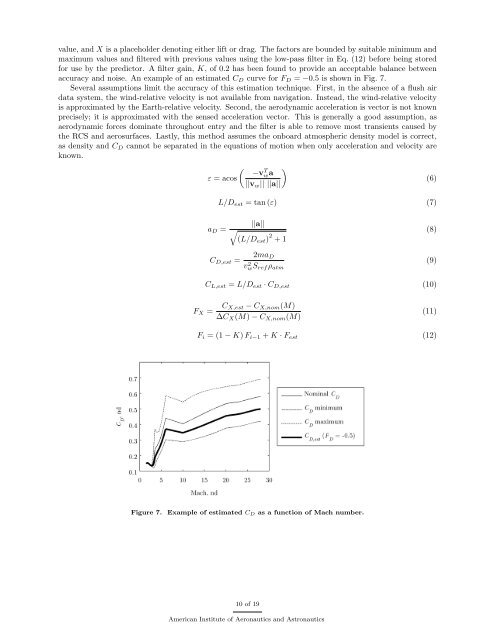Variable Angle-of-Attack Profile Entry Guidance for a Crewed Lifting ...
Variable Angle-of-Attack Profile Entry Guidance for a Crewed Lifting ...
Variable Angle-of-Attack Profile Entry Guidance for a Crewed Lifting ...
You also want an ePaper? Increase the reach of your titles
YUMPU automatically turns print PDFs into web optimized ePapers that Google loves.
value, and X is a placeholder denoting either lift or drag. The factors are bounded by suitable minimum and<br />
maximum values and filtered with previous values using the low-pass filter in Eq. (12) be<strong>for</strong>e being stored<br />
<strong>for</strong> use by the predictor. A filter gain, K, <strong>of</strong> 0.2 has been found to provide an acceptable balance between<br />
accuracy and noise. An example <strong>of</strong> an estimated C D curve <strong>for</strong> F D = −0.5 is shown in Fig. 7.<br />
Several assumptions limit the accuracy <strong>of</strong> this estimation technique. First, in the absence <strong>of</strong> a flush air<br />
data system, the wind-relative velocity is not available from navigation. Instead, the wind-relative velocity<br />
is approximated by the Earth-relative velocity. Second, the aerodynamic acceleration is vector is not known<br />
precisely; it is approximated with the sensed acceleration vector. This is generally a good assumption, as<br />
aerodynamic <strong>for</strong>ces dominate throughout entry and the filter is able to remove most transients caused by<br />
the RCS and aerosurfaces. Lastly, this method assumes the onboard atmospheric density model is correct,<br />
as density and C D cannot be separated in the equations <strong>of</strong> motion when only acceleration and velocity are<br />
known.<br />
( ) −v<br />
T<br />
ε = acos w a<br />
(6)<br />
||v w || ||a||<br />
L/D est = tan (ε) (7)<br />
||a||<br />
a D = √<br />
(L/D est ) 2 + 1<br />
(8)<br />
C D,est =<br />
2ma D<br />
v 2 wS ref ρ atm<br />
(9)<br />
C L,est = L/D est · C D,est (10)<br />
F X =<br />
C X,est − C X,nom (M)<br />
∆C X (M) − C X,nom (M)<br />
(11)<br />
F i = (1 − K) F i−1 + K · F est (12)<br />
Figure 7.<br />
Example <strong>of</strong> estimated C D as a function <strong>of</strong> Mach number.<br />
10 <strong>of</strong> 19<br />
American Institute <strong>of</strong> Aeronautics and Astronautics
















